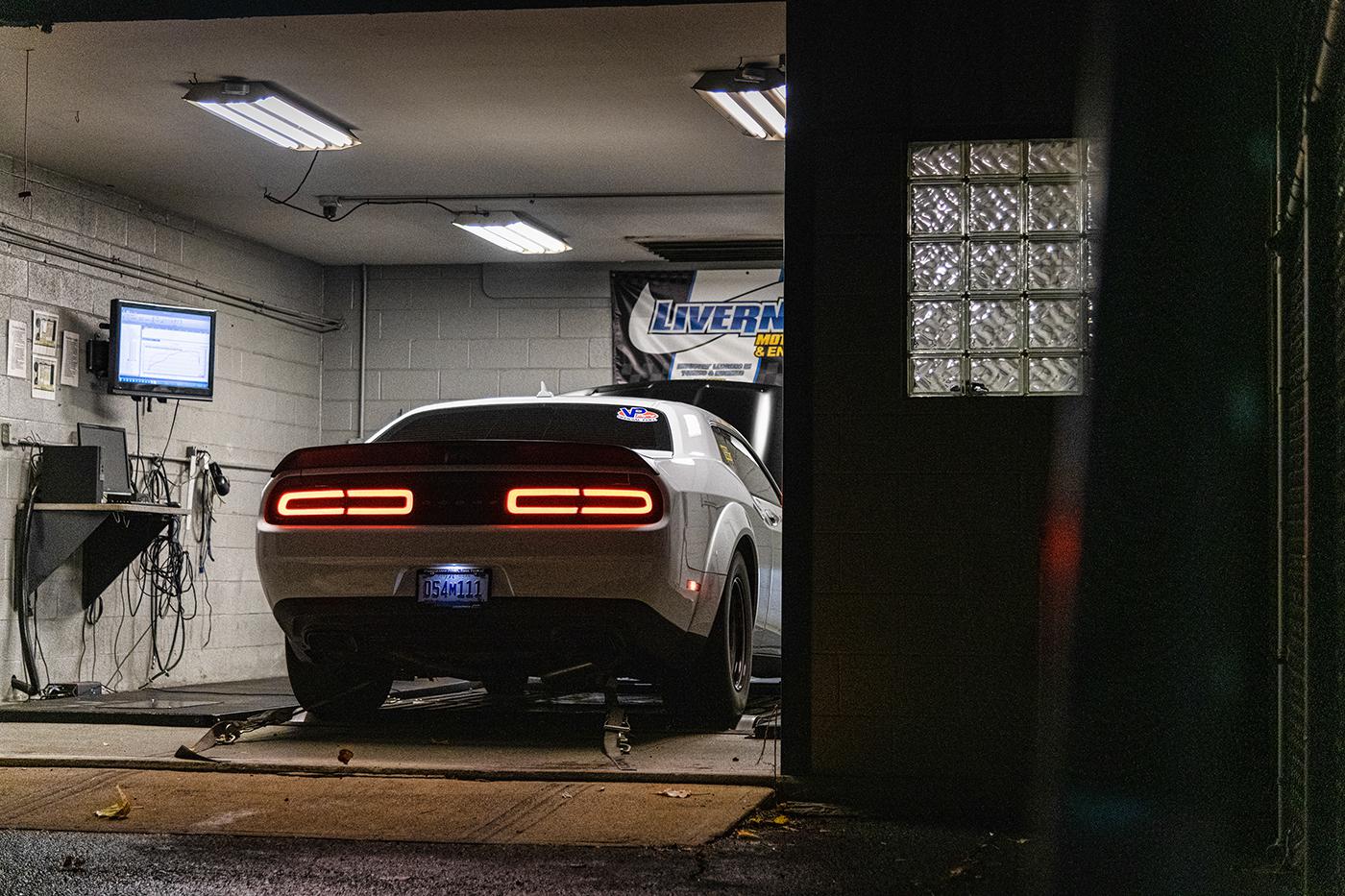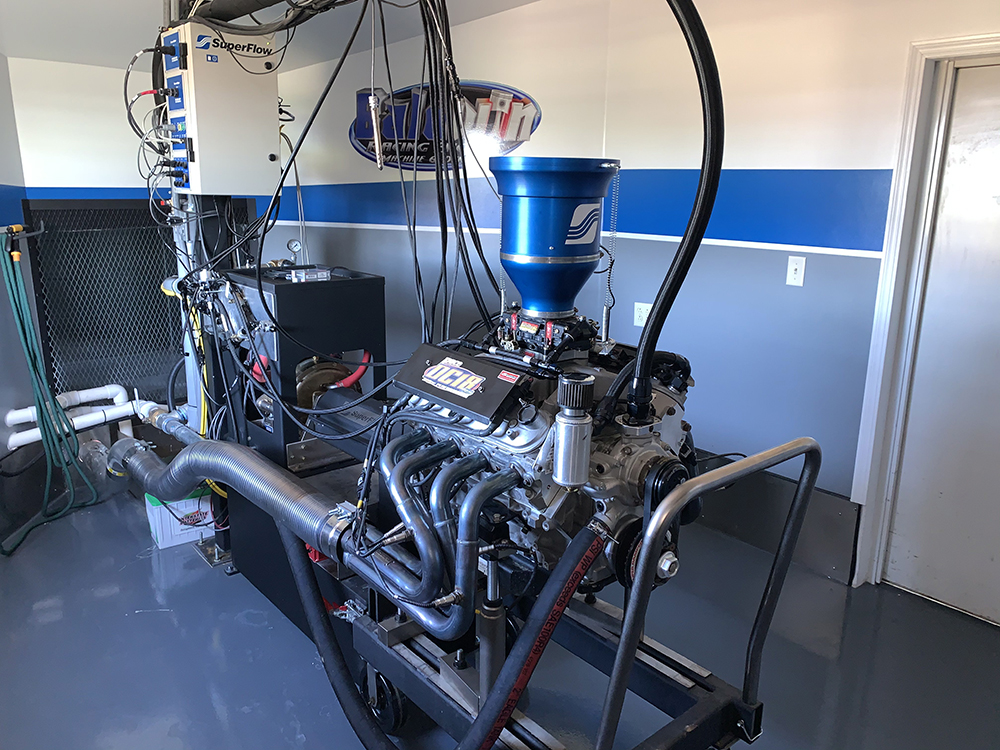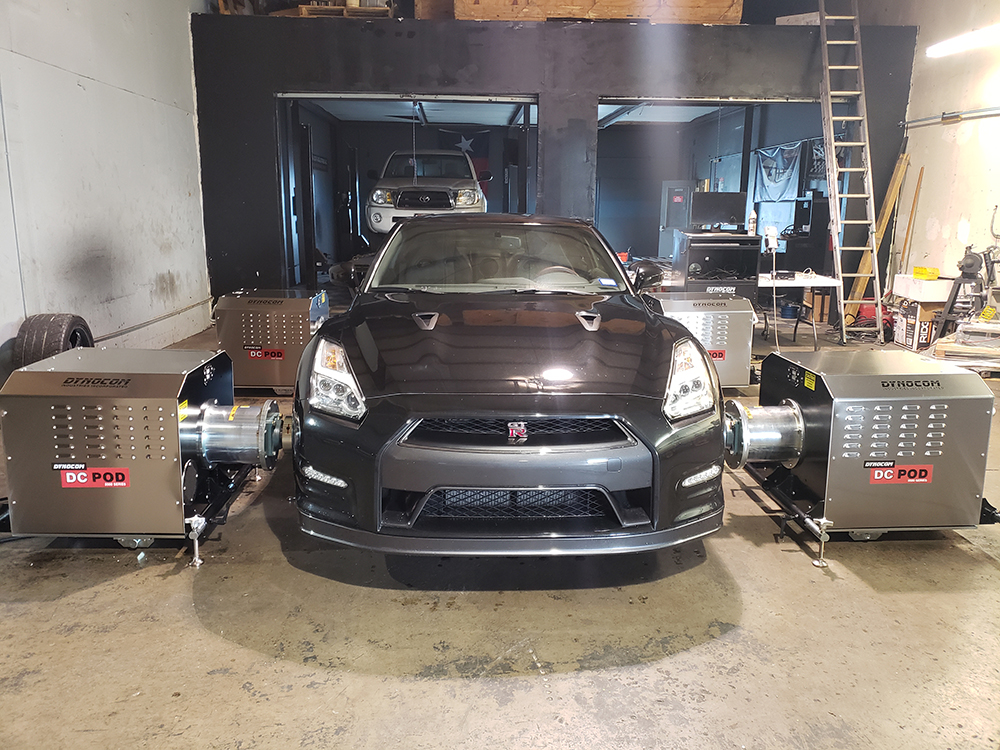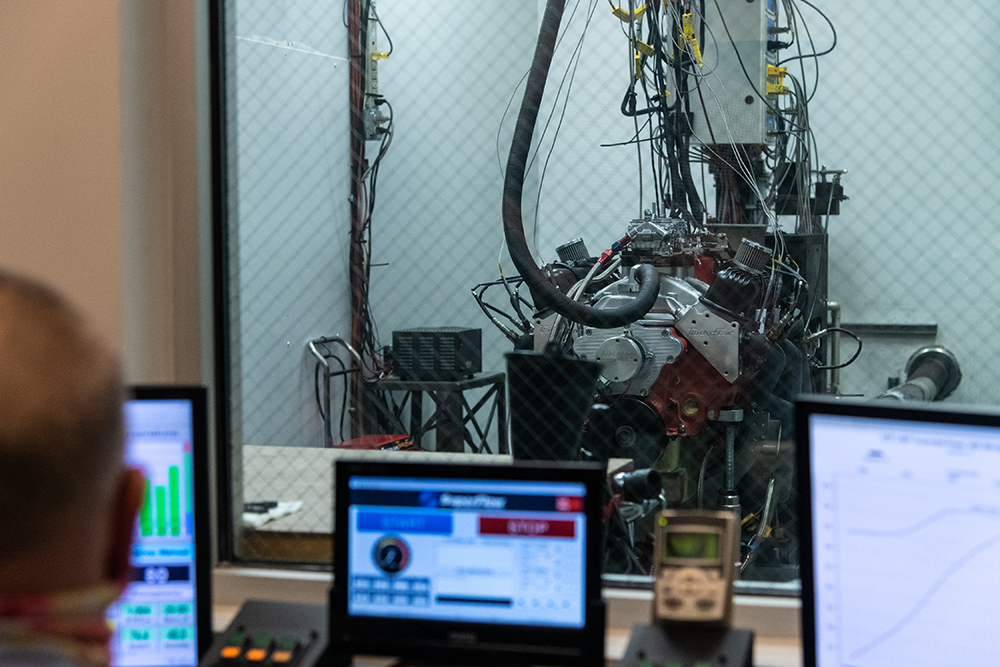quantifying RESULTS

Making a compelling case for adding the ultimate diagnostic tool, leading dyno manufacturers explain why “there’s no substitute for testing.”
A dynamometer can be so many things. At the most basic level, it’s a tool to measure power output, either at the crankshaft with an engine dynamometer or at the wheels with a chassis dynamometer. Yet in the right hands and with the right training—and some imagination—it can be so much more: proof of concept; profit center; marketing tool; an insurance policy to keep customers and sponsors happy.
There’s no question that the initial outlay for a dyno is significant. The unit itself can cost in the tens to hundreds of thousands of dollars. Add tens of thousands more for a test cell to safely enclose and ventilate it. A chassis dyno going in the ground requires a pit (and an agreeable landlord). An above-ground dyno needs ramps or a four-post lift for access. Operator training can take anywhere from hours to days, depending on the dyno’s complexity.

“But once it’s done, it’s an awesome tool, one that separates the men from the boys in racing,” said Travis Thirkettle of SuperFlow, Sussex, Wisconsin. “There’s no substitute for testing, especially with the way the rules are now at most tracks, where there’s limited practice time or limited passes on the strip. Showing up ready because you’ve done your testing beforehand is a big advantage.
“For engine builders, a dyno is almost a necessity,” he added. “How do you quantify your results? Seat of the pants? I’ve run a lot of races, and at a 600-horsepower level I can’t tell a 25- or 50-horsepower change from the seat. But they make a difference. On the dyno you can see 10ths of a horsepower if necessary.”
FIRST, HOMEWORK
Given the time and expense necessary to purchase and install a dynamometer, as well as the number of different dyno products on the market, it’s important to research the options available.
Dynos are rated by the amount of power (expressed as either torque or horsepower) and speed (either rpm or mph) they can accommodate. Because dyno cost often grows with power capacity, a prospective buyer should honestly evaluate the amount of power customers’ cars are putting out.
“We’re not making less power today than we did yesterday,” noted Thirkettle. “Especially in drag racing and the power-adder world we’re living in now. Seems like everybody is able to produce north of 2,000 horsepower. But the guy who primarily works on dirt late model and sprint car crate motors or street cars doesn’t really need that capacity. That’s why we offer different models.”
A function available on certain chassis dyno models is load control. “A load control dyno allows the operator to perform various load tests such as road simulation, step tests, and custom tests they can configure in the software,” explained Will Fong of Dynojet Research, North Las Vegas, Nevada. The alternative, a non-load inertia dyno, “is meant for performing full-throttle tests to measure maximum horsepower and torque, to confirm that the car is producing the expected power at the wheels at full throttle.”
Dyno models are also differentiated by their method of controlling load and absorbing torque. A dyno with an eddy current brake uses “electromagnetism to create a torque reaction that is resisted,” Fong said. The other method is to use a hydraulic brake to create the resistance. Each has its advantages.
“Eddy brakes are much faster to control with digital electronics and have higher torque ratings in steady state—several times greater,” said Allison Blackstein of Dynocom Industries, Fort Worth, Texas.

On the other hand, Dynapack of Clovis, California, sells “hydraulic load brake dynos,” said Scott Lampkin. “We don’t use eddy current, because eddy current can interfere with electronic controls that are in a lot of electric vehicles these days.” Among Dynapack’s customers are Formula E teams and military clients that are testing electric vehicles. “They can’t have the interference that an eddy current load rate would cause.”
When looking at an engine dynamometer’s software, sensors, and data channels, “be sure to get enough expandability for the future,” said Kevin Gertgen of Performance Trends, Livonia, Michigan. “People call us all the time saying they only need torque, horsepower, and rpm. That only requires two channels for torque and rpm data, as horsepower is calculated from those two channels. But then they may want to add a left and right air/fuel, and there are not enough spare channels.”

Gertgen warned, though, that “the more channels and sensors, the more confusing it can be to trace out problems or keep everything running. Most dynos will work well with between 10 to 40 channels. We are very experienced providing guidance to customers to get them the correct system with enough spare channels for the future.”
Specific dynamometer features aside, “functionality, ease of use, and customer support” are the most important considerations when buying a dyno, Fong said. “The dynamometer must be reliable and provide consistent, easily repeatable results,” he explained. “You need reliable data as your starting point to accurately measure any improvements or changes made. Otherwise, you can end up chasing your tail on the dyno.”
“Buyers should understand their customer base and know who is going to be purchasing its services,” added Michael Caldwell of Mustang Dynamometer, Twinsburg, Ohio. “If you have mostly rear-drive American muscle coming through the door, you wouldn’t want an AWD model. A shop that does diesel needs a dyno that’s different from the gas guys, one with a lot of load at low speeds. Buyers should be thinking about return-on-investment and value. This means knowing who is going to be using the machine, so you know which model fits their needs.”
To Blackstein, the two most important considerations for a dyno purchase are “space and budget.” While true for either an engine or chassis dyno, those variables are particularly relevant when considering a chassis dyno, and whether it will be installed in-ground or above it.
Each location has its pros and cons. Some find the in-floor dyno more practical, especially in a smaller shop, as the covered dyno pit provides floor space that can be utilized to park and work on cars when the dyno is not in use. It’s also typically quicker to get a car on and off an in-ground dyno, though lying on the ground to strap it down can be awkward.
But it’s the above-ground dyno that has grown in popularity. “Probably 90% of the dynos we’ve sold in the 2020 calendar year were above ground,” said Caldwell. “The dyno shows up on a flatbed truck, and in four hours you can probably have it unpalletized on your floor, connected to power, and ready to go.”
Getting a car on an above-ground dyno means installing ramps or a four-post lift, depending on the dyno’s height. “But the four-post lift can also be used for non-dyno work,” said Fong.
“It also gives you the flexibility of avoiding what can be fairly expensive construction costs to build a pit,” said Caldwell. “You can pay anywhere from $5,000 to $25,000 for a pit, depending on where you are and how busy the contractors are.”
An above-ground dyno is also much easier to move, should a shop decide to relocate or expand. And it doesn’t leave an empty hole in the building’s floor that a landlord would need to have repaired.
THE HUB DYNO ALTERNATIVE
On the subject of easy-to-move, and to Blackstein’s point about space and budget, is the hub dyno option. This variation of a chassis dyno does not position the vehicle’s tires on rollers, but instead uses adapters to mount the wheel hubs directly to dynamometer pods.
“Dynocom’s patented eddy-current hub dynos are perfect, as they are portable and move around easily,” Blackstein said. “Hub dynos require very little installation—just electrical wiring—compared to other chassis dynos and especially AWD linked dynos, which are much more complex to install.”
“If you have a flat floor, you uncrate a Dynapack hub dyno and it’s ready to run,” said Lampkin. “The whole system runs off a 110 wall outlet. You can even take it to the race track and use it right at the track. Literally, the only thing you need with ours is a set of garden hoses for water cooling because the hydraulic oil in the dyno needs to be cooled by water. And many of our customers don’t even hook up the water until they get above 400 horsepower.”
TEST CELL
When considering a dynamometer installation, the test cell is just as important as the dyno unit itself.
“Whether it’s for a chassis or an engine dyno, most underestimate what is needed for a test room,” said Thirkettle. “The dyno itself is only one piece of the puzzle. It’s not a toaster oven. You don’t just take it out of the box, plug it in, and start making toast. Facility requirements, like airflow, exhaust extraction, noise control, a water system for cooling, and the fuel system, are all important. The dyno is just one part of it. To get superior repeatability and accuracy you need a proper environment for the dyno to be in. It’s only as good as the test cell.”
“We look at the test cell from a dyno and engine perspective—what the engine’s going to need to run effectively in the test cell,” said Jason Kardell of Noise Barriers, Elk Grove Village, Illinois, which makes Soundmaster dyno test cells. “We ensure the test cell is not going to be the thing that inhibits your power ratings. Ever been in a test cell where you open the door, and the engine starts running freer? That’s bad airflow design.”
The typical Soundmaster engine test cell “is 12 feet by 16 feet by 8 feet,” Kardell said. “That covers most of your medium- to high-performance dynos. With our silenced ventilation system, you can get from 20,000 to 24,000 cfm through a cell like that.”
Each cell is “custom tailored to the testing application, the types of engines that will be running, the duration of tests, horsepower levels, things like that,” he continued. And all the cell materials are pre-cut to length, “so assembly is very fast. Usually, a crew of about three guys can install most cells in two to three days.”
Kardell acknowledged test cells are less commonly used with chassis dynos. “In a lot of cases we’re the second thought with a chassis dyno. Everybody’s excited to get their chassis dyno, but after they put it in their shop, they’ll get into trouble from the municipality.” Neighbors don’t like the noise, he said. “The shop owners really need to understand their local environment, what’s around them. Test cells are the best solutions for keeping your neighbors happy. We can do the same amount of noise control in one of our test cells as an eight-inch-thick block wall that’s been sand filled.”
POTENTIAL FOR UPGRADES
It’s common for the owner/operator of a new dynamometer to want to upgrade the system after it’s been in operation for a while.
“Once they get it and realize what it can do, their needs change,” said Thirkettle. “We’re only providing the tools. It takes the engine builder to produce the product. As he learns things on the dynamometer, that triggers him to dig further. We have hundreds of data channels already in the system. They just need to add the sensors. That allows them to expand their abilities as they go.”
“What we do is give the customer options,” said Gertgen. “Maybe they can do 80% of what they want with their existing system, but just use it a little smarter. For example, what if you don’t measure turbo exhaust pressure for this next test? Then you can use that pressure sensor for, say, oil pressure somewhere else in the block to solve an oiling issue.”
A shop may want to add sensors to “set it above the competition,” he added. “It could offer measuring blow-by, or airflow and calculate volumetric efficiency, or measure eight individual cylinder A/Fs, or measure spark advance. Offering more services can easily bring in more business, both for the dyno and engine building.”
Installing a dyno can effect changes in the shop’s business model, too, said Caldwell, leading to an eventual dyno upgrade. “The dyno purchase can increase a shop’s visibility. Now they have people stopping in that weren’t before, having heard the dyno was there.”
He shared a story about a customer who bought a 2WD Mustang dyno three years ago, “and he just purchased an AWD upgrade. When he got the dyno, people interested in doing work with him changed. And in the years since he bought the unit, the number of AWD vehicles on the road increased. Having recouped the cost of the original dyno sooner than he thought, doing an AWD upgrade looked like a no-brainer.”
Upgrades can also come directly from the dyno manufacturers. Most of the companies we spoke with use web-based software, so they can push updates and revisions to their customers automatically.
“Dynojet software updates to existing software are included for free,” said Fong. “The only additional purchases are typically data acquisition accessories if they weren’t originally purchased with the dyno.”
At Dynocom, “software updates are continuous,” said Blackstein. The company has also released a new controller platform, the Gen 5, that “offers the ability to datalog right from the vehicle’s ECU, whether it’s OEM or aftermarket,” she said.
OPPORTUNITIES
“There’s no shortage of work right now for most of the shops out there,” Caldwell pointed out. “Most of the dynos we sell are going to people who are tuning street cars. Detroit is making muscle cars again, and a lot of the younger kids are interested in it. Doesn’t matter if you’re into classic muscle car stuff or modern muscle, you’re busy.”
The dyno can also be a marketing tool, Thirkettle said. “It allows shops to show off their engines running on dynos, making lots of noise, with gauges flashing and all that kind of stuff. It helps them sell engines.”
Ultimately, though, a dyno can help win races.
“Richard Childress, Hendrick Motorsports, or KB Racing, they don’t use it to bring in income,” Thirkettle said. “They don’t test anyone else’s stuff. They use it to make themselves faster or to finish races. At a professional level, every single engine that goes on the race track has gone across the dyno. There’s no way in heck they would go out racing without testing them.”
 MEMBERSHIP LOGIN
MEMBERSHIP LOGIN JOIN PRI
JOIN PRI


